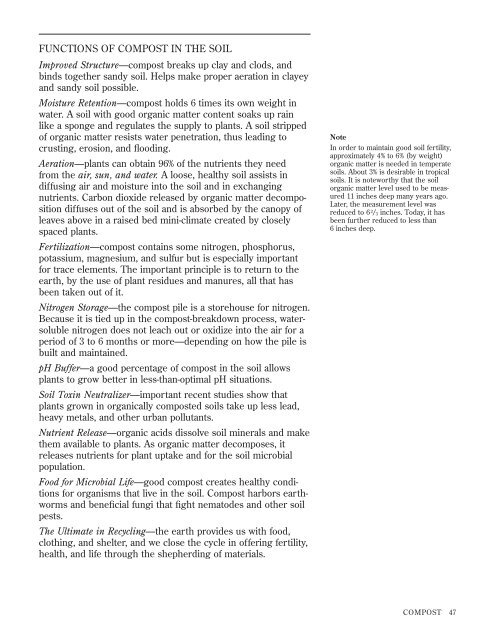How to Grow More Vegetables : And Fruits, Nuts ... - Shroomery
How to Grow More Vegetables : And Fruits, Nuts ... - Shroomery
How to Grow More Vegetables : And Fruits, Nuts ... - Shroomery
Create successful ePaper yourself
Turn your PDF publications into a flip-book with our unique Google optimized e-Paper software.
FUNCTIONS OF COMPOST IN THE SOIL<br />
Improved Structure—compost breaks up clay and clods, and<br />
binds <strong>to</strong>gether sandy soil. Helps make proper aeration in clayey<br />
and sandy soil possible.<br />
Moisture Retention—compost holds 6 times its own weight in<br />
water. A soil with good organic matter content soaks up rain<br />
like a sponge and regulates the supply <strong>to</strong> plants. A soil stripped<br />
of organic matter resists water penetration, thus leading <strong>to</strong><br />
crusting, erosion, and flooding.<br />
Aeration—plants can obtain 96% of the nutrients they need<br />
from the air, sun, and water. A loose, healthy soil assists in<br />
diffusing air and moisture in<strong>to</strong> the soil and in exchanging<br />
nutrients. Carbon dioxide released by organic matter decomposition<br />
diffuses out of the soil and is absorbed by the canopy of<br />
leaves above in a raised bed mini-climate created by closely<br />
spaced plants.<br />
Fertilization—compost contains some nitrogen, phosphorus,<br />
potassium, magnesium, and sulfur but is especially important<br />
for trace elements. The important principle is <strong>to</strong> return <strong>to</strong> the<br />
earth, by the use of plant residues and manures, all that has<br />
been taken out of it.<br />
Nitrogen S<strong>to</strong>rage—the compost pile is a s<strong>to</strong>rehouse for nitrogen.<br />
Because it is tied up in the compost-breakdown process, watersoluble<br />
nitrogen does not leach out or oxidize in<strong>to</strong> the air for a<br />
period of 3 <strong>to</strong> 6 months or more—depending on how the pile is<br />
built and maintained.<br />
pH Buffer—a good percentage of compost in the soil allows<br />
plants <strong>to</strong> grow better in less-than-optimal pH situations.<br />
Soil Toxin Neutralizer—important recent studies show that<br />
plants grown in organically composted soils take up less lead,<br />
heavy metals, and other urban pollutants.<br />
Nutrient Release—organic acids dissolve soil minerals and make<br />
them available <strong>to</strong> plants. As organic matter decomposes, it<br />
releases nutrients for plant uptake and for the soil microbial<br />
population.<br />
Food for Microbial Life—good compost creates healthy conditions<br />
for organisms that live in the soil. Compost harbors earthworms<br />
and beneficial fungi that fight nema<strong>to</strong>des and other soil<br />
pests.<br />
The Ultimate in Recycling—the earth provides us with food,<br />
clothing, and shelter, and we close the cycle in offering fertility,<br />
health, and life through the shepherding of materials.<br />
Note<br />
In order <strong>to</strong> maintain good soil fertility,<br />
approximately 4% <strong>to</strong> 6% (by weight)<br />
organic matter is needed in temperate<br />
soils. About 3% is desirable in tropical<br />
soils. It is noteworthy that the soil<br />
organic matter level used <strong>to</strong> be measured<br />
11 inches deep many years ago.<br />
Later, the measurement level was<br />
reduced <strong>to</strong> 6 2/3 inches. Today, it has<br />
been further reduced <strong>to</strong> less than<br />
6 inches deep.<br />
COMPOST 47












